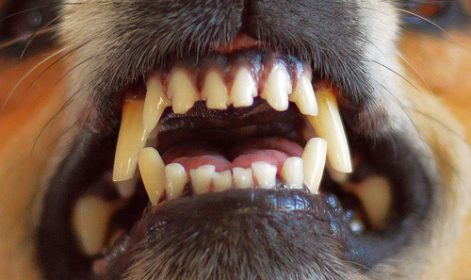
Most breed standards mention teeth in terms of bite, i.e., a scissors bite, a level bite, etc., but one or two standards include curious comments. The Gordon Setter’s standard, for example, indicates that “pitted teeth from distemper or allied infections are not penalized.”
Some standards refer to tooth size, references that offer clues to the breed’s original purpose. A Dandie Dinmont should have canines which are “an extraordinary size for a small dog” which makes total sense for a breed that hunted badgers, an ill tempered critter if ever there was one. The Dogo Argentino’s standard also calls for “teeth big,” something the creators certainly wanted in a breed developed to hunt wild boar and pumas. And see if you can guess the breed by the wording used in the breed standard to describe its teeth: Teeth should be large and strong, with the canine teeth or tusks wide apart, and the six small teeth in front, between the canines, in an even, level row.
What breed would need to have its canines “wide apart?”
The Bulldog, of course. Perfectly logical for a breed that originally helped butchers control livestock quite literally by the nose.
It’s said that the Working Group has the strictest dental standards of all the groups, and show judges who know their standards enough to carefully inspect teeth are known as “tooth fairies.” Just ask the people who exhibit Giant Schnauzers, Doberman Pinschers,American Eskimo dogs, Rottweilers, German Pinschers, Border Collies, Bernese Mountain Dogs, Tibetan Mastiffs, Australian Shepherds, and Leonbergers, among the breeds that must have either “full dentition,”a “full complement,”or exactly 42 teeth. Several breed standards consider a specific number of missing teeth to be a disqualification. Black Russian Terriers and Rottweilers can be disqualified for two or more missing teeth, Komondors and Beaucerons for three or more, and Doberman Pinschers, four or more.
Did you know that the Orthopedic Foundation for Animals (more commonly known as OFA) has an established dentition database? It’s open to all breeds and is used to certify full dentition in an adult (but not to certify compliance with a specific breed standard).
